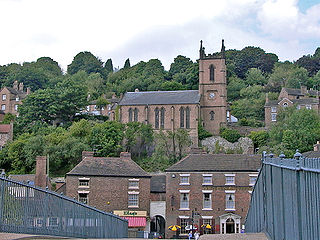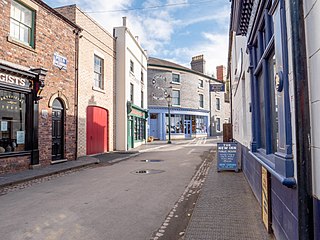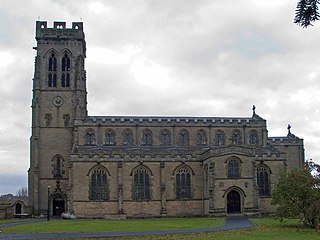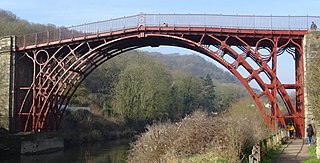
Shropshire is a landlocked historic county in the West Midlands region of England bordering Wales. Shropshire borders with the English counties of Cheshire to the north, Staffordshire to the east, Worcestershire to the southeast, and Herefordshire to the south, and bordering Wales with the counties of Wrexham and Powys to the west. A unitary authority of the same name was created in 2009, taking over from the previous county council and five district councils, now governed by Shropshire Council. The borough of Telford and Wrekin has been a separate unitary authority since 1998, but remains part of the ceremonial county.

Ironbridge is a large village in the borough of Telford and Wrekin in Shropshire, England. Located on the bank of the River Severn, at the heart of the Ironbridge Gorge, it lies in the civil parish of The Gorge. Ironbridge developed beside, and takes its name from, The Iron Bridge, a 100-foot (30 m) cast iron bridge that was built in 1779.

Telford is a town in Shropshire, England. It is the administrative centre of Telford and Wrekin borough, a unitary authority which covers the town, its suburbs and surrounding settlements. The town is inland and near the River Severn.

The Ironbridge Gorge is a deep gorge, containing the River Severn in Shropshire, England. It was first formed by a glacial overflow from the long drained away Lake Lapworth, at the end of the last ice age. The deep exposure of the rocks cut through by the gorge exposed commercial deposits of coal, iron ore, limestone and fireclay, which enabled the rapid economic development of the area during the early Industrial Revolution.

Oakengates is a constituent town of Telford and a civil parish in the borough of Telford and Wrekin, Shropshire, England. The towns parish population was recorded as 8,517 in the 2001 census.

Donnington is an area / housing estate located in the borough of Telford and Wrekin and ceremonial county of Shropshire, England. The population of Donnington Ward was 6,883 at the 2011 census.

Blists Hill Victorian Town is an open-air museum built on a former industrial complex located in the Madeley area of Telford, Shropshire, England. The museum attempts to recreate the sights, sounds and smells of a Victorian Shropshire town in the late 19th and early 20th centuries. It is one of ten museums operated by the Ironbridge Gorge Museum Trust.
Shropshire was established during the division of Saxon Mercia into shires in the 10th century. It is first mentioned in 1006. After the Norman Conquest it experienced significant development, following the granting of the principal estates of the county to eminent Normans, such as Roger De Montgomery and his son Robert de Bellême.

Broseley is a market town in Shropshire, England, with a population of 4,929 at the 2011 Census and an estimate of 5,022 in 2019. The River Severn flows to its north and east. The first iron bridge in the world was built in 1779 across the Severn, linking Broseley with Coalbrookdale and Madeley. This contributed to the early industrial development in the Ironbridge Gorge, which is now part of a World Heritage Site.

Lilleshall is a village and civil parish in the county of Shropshire, England.

Madeley is a constituent town of Telford and a civil parish in the borough of Telford and Wrekin, Shropshire, England. The parish had a population of 17,935 at the 2001 census.
The geology of Shropshire is very diverse with a large number of periods being represented at outcrop. The bedrock consists principally of sedimentary rocks of Palaeozoic and Mesozoic age, surrounding restricted areas of Precambrian metasedimentary and metavolcanic rocks. The county hosts in its Quaternary deposits and landforms, a significant record of recent glaciation. The exploitation of the Coal Measures and other Carboniferous age strata in the Ironbridge area made it one of the birthplaces of the Industrial Revolution. There is also a large amount of mineral wealth in the county, including lead and baryte. Quarrying is still active, with limestone for cement manufacture and concrete aggregate, sandstone, greywacke and dolerite for road aggregate, and sand and gravel for aggregate and drainage filters. Groundwater is an equally important economic resource.

The Iron Bridge is a cast iron arch bridge that crosses the River Severn in Shropshire, England. Opened in 1781, it was the first major bridge in the world to be made of cast iron. Its success inspired the widespread use of cast iron as a structural material, and today the bridge is celebrated as a symbol of the Industrial Revolution.
Open-pit coal mining in the United Kingdom is in decline. Output has fallen every year since 2010. In 2010, the United Kingdom was forecast to produce about ten million tonnes of coal a year from open-pit mines. Most came from Scotland, with the largest operator there being the Scottish Coal subsidiary of Scottish Resources Group. Actual production in 2010 was over 13 million tonnes but this has declined to less than 8 million tonnes in 2014. Deep coal mining stopped completely at the end of 2015 and the UK is planning to phase out the use of coal to produce electricity by 2024.

The Fife Coalfield was one of the principal coalfields in Scotland. Over fifty collieries were in operation at various times between the middle of the nineteenth century and the closure of the last pit in 1988. The coalfield extended across the southern part of Fife where rocks of the Coal Measures Group occur and was one of a series of coalfields throughout the Midland Valley from which coal was won by both deep workings and opencasting methods. It is traditionally divided into the West Fife, Central Fife and East Fife coalfields with Kirkcaldy having been a particularly important area. Some of the mines extended beyond Fife under the Firth of Forth following the seams which occupy the Leven Syncline which extends to the south shore of the firth at Musselburgh and beyond.

The coal industry in Wales played an important role in the Industrial Revolution in Wales. Coal mining in Wales expanded in the 18th century to provide fuel for the blast furnaces of the iron and copper industries that were expanding in southern Wales. The industry had reached large proportions by the end of that century, and then further expanded to supply steam-coal for the steam vessels that were beginning to trade around the world. The Cardiff Coal Exchange set the world price for steam-coal and Cardiff became a major coal-exporting port. The South Wales Coalfield was at its peak in 1913 and was one of the largest coalfields in the world. It remained the largest coalfield in Britain until 1925. The supply of coal dwindled, and pits closed in spite of a UK-wide strike against closures. Aberpergwm Colliery is the last deep mine in Wales.
The Cinderloo Uprising took place at Old Park in the Coalbrookdale Coalfield on 2 February 1821, when the South Shropshire Yeomanry confronted a crowd of 3,000 mostly striking workers who had gathered to protest the continued lowering of their pay.













